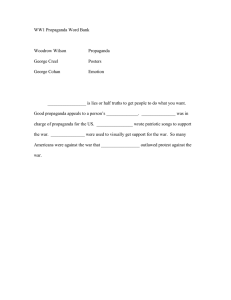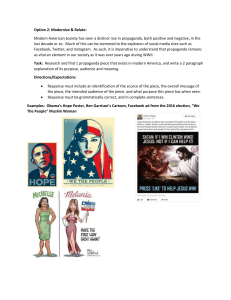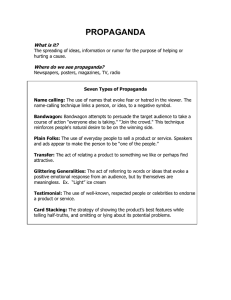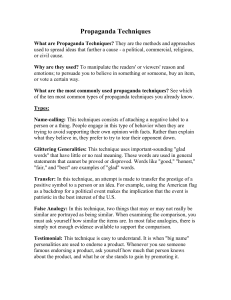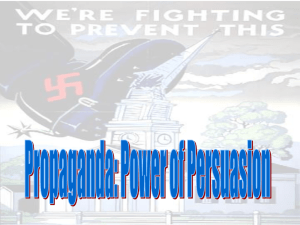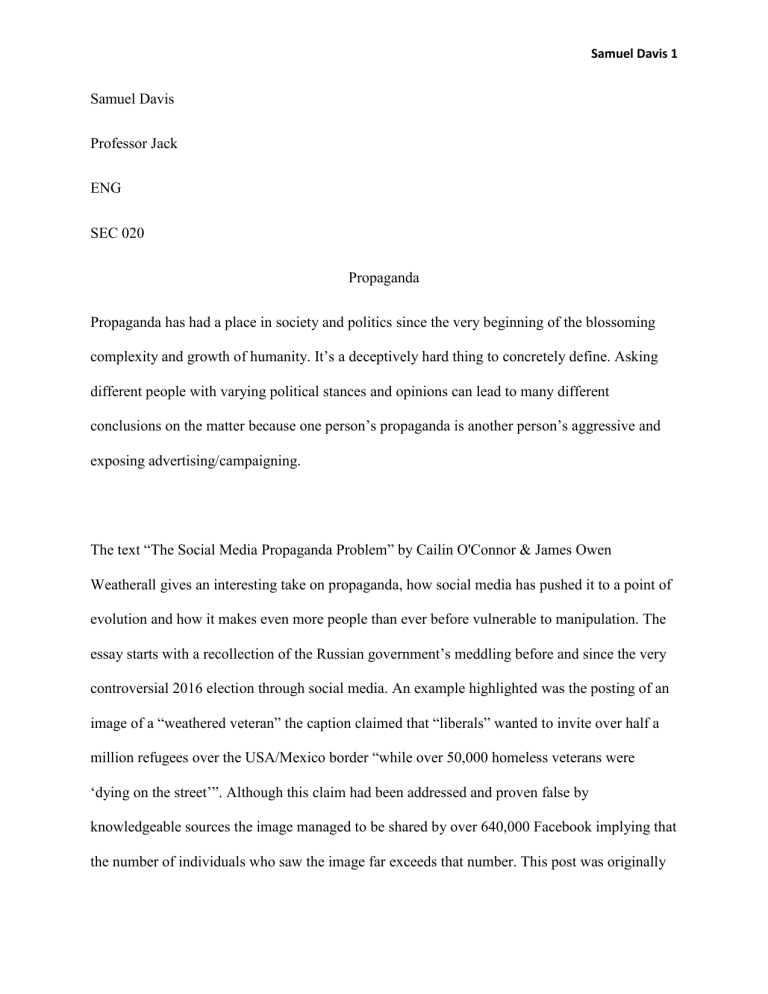
Samuel Davis 1 Samuel Davis Professor Jack ENG SEC 020 Propaganda Propaganda has had a place in society and politics since the very beginning of the blossoming complexity and growth of humanity. It’s a deceptively hard thing to concretely define. Asking different people with varying political stances and opinions can lead to many different conclusions on the matter because one person’s propaganda is another person’s aggressive and exposing advertising/campaigning. The text “The Social Media Propaganda Problem” by Cailin O'Connor & James Owen Weatherall gives an interesting take on propaganda, how social media has pushed it to a point of evolution and how it makes even more people than ever before vulnerable to manipulation. The essay starts with a recollection of the Russian government’s meddling before and since the very controversial 2016 election through social media. An example highlighted was the posting of an image of a “weathered veteran” the caption claimed that “liberals” wanted to invite over half a million refugees over the USA/Mexico border “while over 50,000 homeless veterans were ‘dying on the street’”. Although this claim had been addressed and proven false by knowledgeable sources the image managed to be shared by over 640,000 Facebook implying that the number of individuals who saw the image far exceeds that number. This post was originally Samuel Davis 2 posted by a Facebook group called “Being Patriotic” which according to the Muller Report was created by the Internet Research Agency (IRA) an agency responsible for the majority of the Russian state-sponsored media campaigns. According to O’Conner, this whole scheme was made with the intent to “undermine democratic functioning in the United States and throughout Europe. Its campaign targeted social media users on both the right and the left by producing and sharing intentionally divisive images and other content…”. Whether or not this claim is fact or conjecture the underlying intent and attempt to mislead and or misinform is still present. Other major talking points that this essay aims to discuss are the nuances between misinformation and disinformation. These two concepts albeit extremely similar to one another, can morph between each other and are seldom distinguished they still represent separate concepts that cannot be handled or treated interchangeably. Misinformation is defined as “false or inaccurate information” by the Oxford Dictionary. Disinformation however is defined as “false information which is intended to mislead” these at first may seem distinct and very hard to confuse but the chaos starts amongst the blurry lines. Our society nowadays is surrounded by incredible technology that allows for near-instantaneous communication between strangers and friends alike. This global community has undeniable benefits like the distribution of information between many people as well as glaring drawbacks one of which ironically is the distribution of information between many people. The difference between the two is that one can share useful information with others while another may share false information either intentionally or accidentally. Information has no specific definition and forever changes thus dis and misinformation are more like two points connected in various ways like a web. The very roots on which our modern society is built are fundamentally flawed at least in terms of the way information is shared. Because more people than ever before can produce and share information, Samuel Davis 3 it’s easier than ever to fool and mislead other people and use them as unwilling pawns to spread just about any message. One major capability of social media nowadays is its ability to turn what was intended to and made to be disinformation and turn it into misinformation over time. The concept is unfortunately relatively simple when a piece of information has been created to intentionally mislead and deceive and does as its name suggests a viewer A has been disinformed. However, as most people do when they see something that interests them viewer A, still a bit skeptical, shares it with viewer B, and B being a bit more convinced shares it with viewer C, and C fully convinced at this point in the chain shares it with viewer D whatever was shared cannot be classified as disinformation anymore because the intent to deceive was no longer present. [Finish analogy, Ref human social learning Quote O’Conner, talk about how it’s used in terms of propaganda a little, Wrap up} “History is the link to the future. If you know the history, you’ll know the future” said Indonesian historian, Asep Kambali. Like many things happening today, the way propaganda operates and the core principles it’s built on haven’t changed much throughout and despite the passage of time. The article “How to Detect Propaganda” was published in January of 1938 being the first article in the 24th volume of the Bulletin of the American Association of University Professors (1915-1955). Despite the 100th-year mark of this bulletin’s start is long gone at this point, all the devices referenced in the article are still used and are being built upon today. There are several devices of propaganda discussed in the article and each one has its modern-day equivalent. As with misinformation, propaganda is almost impossible to narrow down perfectly so the devices mentioned aren’t indispensable foundations and strict definitions, Samuel Davis 4 but helpful starting points formed from the opinion of a set of individuals. There are seven devices listed out and discuss in the article namely “1. The Name-Calling Device 2. The Glittering Generalities Device 3. The Transfer Device 4. The Testimonial Device 5. The Plain Folks Device 6. The Card Stacking Device 7. The Band Wagon Device”. All these devices still have their place in modern politics and with or without a slight name change can still be easily recognized. The name-calling device isn’t much more complicated than its name suggests it’s simply attempting to paint a picture of certain individuals, groups, ideals, beliefs, decisions, and practices in a negative light prompting condemnation and rejection. Glittering generalities are the idea of getting someone to support or resonate with an idea that they may not truly understand using generalities, vague comments, and what the article refers to as “virtue words”. These words aim to trigger emotions and foster a sense of togetherness by using vague statements that sound perfectly reasonable and aren’t entirely untrue but can mask an entirely different intention. The article refers to words like “truth, freedom, honor, liberty, social justice, public service, the right to work, loyalty, progress, democracy…” these words and the ideals they represent make people trust and believe sometimes without evidence that their beliefs are well placed. The transfer device is in essence simply leaching off of the authority, Samuel Davis 5 sanction, and prestige of something that is well-known and respected in a society like the church, popular shows that represent a certain demographic, or an entire nation. Testimonials are merely devices, or anything used to convince viewers of points the propagandist is trying to convey. The “Plain Folks” device is used by politicians, advertisers, and organizations to win confidence from individuals to make themselves appear as ‘just your average person’, then allows them to claim that they understand what everyone is going through and know how to fix those issues. The “Band Wagon” is a device designed to tap into humans’ natural desire to not get left out or to join in on what is most popular sometimes without the necessary knowledge or context. Parading words like “everyone is doing it’ or ‘join the millions of others like you who do/support’ with the intent to place themselves in popular culture through common threads. The “Card Stacking” device is when the propagandist aims to deceive and gain support for their cause by any means. This includes but isn’t limited to lies, censorship, red herrings, telling and replacing reality with half-truths, obfuscating the flow of information, and much more. These devices merely serve as a base constantly being built upon by generations of politicians. Differences and perspectives on both essays centered around card stacking and bandwagoning most likely. Fetterman and Oz examples of propaganda in ads and social media and Twitter posts Samuel Davis 6

